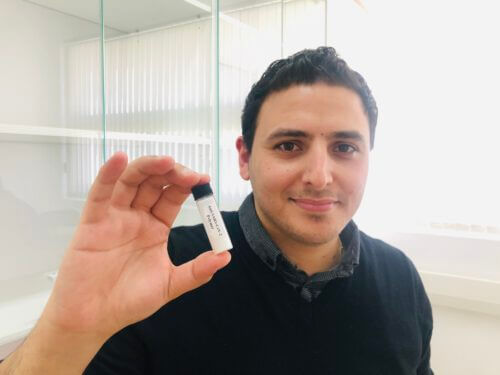Unlike bleach and similar substances used to disinfect surfaces, the new substances damage the infection mechanism of the virus and remain active for a long time

Researchers at the Wolfson Faculty of Chemical Engineering at the Technion have developed smart disinfectants that damage the infection mechanism of the corona virus and remain active for a long time. These substances are expected to replace bleach, as well as other chlorine-based substances, whose disinfecting effect soon wears off.
Dr. Shadi Farah from the Wolfson Faculty of Chemical Engineering, who leads the research, was informed that the European Institute of Innovation and Technology (EIT) will support the project to speed up the development process and bringing the product to market. This is through the prestigious EIT Health grant given for the first time to a single researcher at the Technion. According to Dr. Farah, "We are currently producing potential materials and testing them, with the intention of choosing the optimal material and starting its mass production in the coming months."
The SARS-CoV-2 corona virus belongs to a broad family of viruses known to the world for many years, and some of them can also infect humans (human corona viruses). Although the new virus is largely similar to one of its predecessors - the SARS virus (SARS-CoV), which also developed in China and spread to dozens of other countries - however, the measures taken in that epidemic are not effective in the current epidemic. Currently there is no approved effective treatment for SARS-CoV-2 and no vaccine against it.
Therefore, there is a need for effective disinfectants that will stop the infection-through-surfaces. The new virus, it turns out, is able to survive on different surfaces for extended periods, which vary according to the type of surface and other conditions. According to the findings from the "corona ship" Diamond Princess, it may last on surfaces for even 17 days. This fact obviously increases the likelihood of infection through contact with contaminated surfaces, in addition to direct infection from person to person.
Dr. Farah's research group, which is engaged in the development of innovative polymers for medical uses and smart technologies for drug administration, quickly rose to the challenge and began to develop dedicated antiviral polymers that act on the virus in two mechanisms: first, they change its structure and damage its function, thus disabling its ability to infect ; And in addition, they attack the envelope of the virus and thus break it down. Equally important, the release of the disinfectants is done in a controlled and continuous manner, hence the long-term effect of the new technology.
Since the beginning of the corona epidemic, disinfectants have of course been used to prevent infection through surfaces. The main means of disinfection is spraying with hypochlorite, known in Israel as bleach. This method has some significant limitations: it is a liquid that evaporates quickly, and under sunlight (or UV radiation from another source) it breaks down even faster. Therefore, it is a limited and short-term disinfection that requires repeating the spraying several times a day.
The new technology developed by Dr. Farah's research group makes it possible to produce dedicated disinfectants based on cheap and readily available raw materials. The development of the aforementioned technology was made possible thanks to the integration of interdisciplinary knowledge in combinatorial chemistry, polymer engineering and controlled release. According to Dr. Farah, "the materials we developed will change the rules of the game because they will stop the cycle of infection associated with contact with contaminated surfaces. Infection through surfaces is a difficult problem especially in public places such as hospitals, factories, schools, shopping malls, central stations and public transport, and our polymers will make them safer spaces. It is important to note that the current development was accelerated in order to deal with the current epidemic, but the technology could be used in the future against other microorganisms. This is how we enrich the arsenal of tools at our disposal and add to it a new family of disinfectants that release the active substance in a controlled manner. That way they remain effective over time."
Dr. Shadi Farah completed his three degrees at the Hebrew University, and did his doctorate (direct track) in medicinal chemistry. He then went on to do a post-doctorate at MIT (under the guidance of Prof. Robert Langer) and at the Children's Hospital in Boston belonging to the Harvard Medical School. He is currently a Neubauer faculty member in the Wolfson Faculty of Chemical Engineering and a researcher at the Russell Berry Nanotechnology Institute (RBNI). In addition, he was awarded a scholarship from AUF for young faculty members and his laboratory received generous funding from the Neubauer Family Foundation.

One response
Good and important
only
Why sing in Leaz?
In the body of the article it says "activists",
So why in the secondary title
"Effective" writers?
Hebrew is indeed a difficult language
But when there are terms in Hebrew
It is not appropriate to speak in Laez...